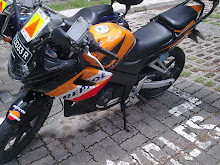Session 8: Interactive Design
Yup. Session 8 was all about design. In this session, we started the session with presentation of proof-of-concept for each team. We presented our proof of concept in different way this time. Instead of using power point or flash, we did it by using skit !!! And then followed by demo of our sub application inside eSing, our business plan. This application is a bus guide. But it is not like old fashioned street directory book, this application is dedicated to mobile phone and the user can access this application from their own phone. Here is the snapshot of the bus guide application

Another interesting presentation was conducted by Team Visionaries. Their user interface design was very attractive. They did it using Flash. Before you interact with the user interface, you'll never know what's inside. But once you interact with the apps, you will be amazed by this interface. This interface will attract your attention and it will enhance a user experience.
Okay, let's go to the lesson. In this session we discussed about designing an interface for application especially in Critical Design Trends for application developer when designing an application. Prof. Gilbert gave us nice analogy by using a simple game. This game required the two players to each take turn to choose a number for a set of numbers between 1 to 9 till either side got a total of 15 from the addition of the numbers each pick. At the beginning, the class confused about the game rule. The game rule seemed complicate and hard to play. Eventually, this game is a version of Tic Tac Toe game that I'm sure you all know how to play. Moral of the story is with proper interface, the application will be easier to understand by customer.
Actually, I'm quite interesting with one of the slides that Prof. Gilbert gave us from edventure. It is a slide about Creating Initial Design. Well, the contents of this slide are related with my Industrial Attachment. Before I share my IA experience about creating a User Interface for our application, let's highlight the contents of the slide. Here they are:
- Intelligent borrowing
- Derive principles from other applications
- Copy specific interaction techniques
- Only then conside a new solutions
 Refer to figure above, all the buttons in the User Interface are placed on the right side (right-alligned style) and Microsoft as well as Windows always put their trio buttons ('OK' button, 'Cancel' button, 'Apply' button) on the corner of the Windows.
Refer to figure above, all the buttons in the User Interface are placed on the right side (right-alligned style) and Microsoft as well as Windows always put their trio buttons ('OK' button, 'Cancel' button, 'Apply' button) on the corner of the Windows.And at that time, I didn't follow this kind of example. I designed the user interface with my own design. In the end, one of my friends told me that your application is not a Windows application if the User Interface design is different from what Windows does. =D
So, moral of the story is, follow what Windows does when you design User Interface for a Windows-based application.
Okay, le't go to session 9. I think its enough for session 8 review :p..
Session 9: Scenario Planning
Let's start from the definition of scenario planning. In formal definition, Scenario planning or Scenario thinking is a strategic planning method that some organizations use to make flexible long-term plans. It is in large part an adaptation and generalization of classic methods used by military intelligence.
he basic method is that a group of analysts generate simulation games for policy makers. The games combine known facts about the future, such as demographics, geography, military, political, industrial information, and mineral reserves, with plausible alternative social, technical, economic and political (STEP) trends which are key driving forces.
Scenario planning can include anticipatory thinking elements that are difficult to formalize, such as subjective interpretations of facts, shifts in values, new regulations or invention
In this session, Prof. Gilbert highlighted the importance of scenario planning to help in our forecast about competitor's strategy. In this session, Prof. Gilbert gave us an example using a table to represent the Structural Dimension and Scenarios. We need to identify the structural factors for decision making process. Looking at 3 or 4 dimensions is very good to analyze the problem. Using only 2 dimensions will result in many way of contradicting answers.
That's all for these 2 sessions =D
Ciao..









